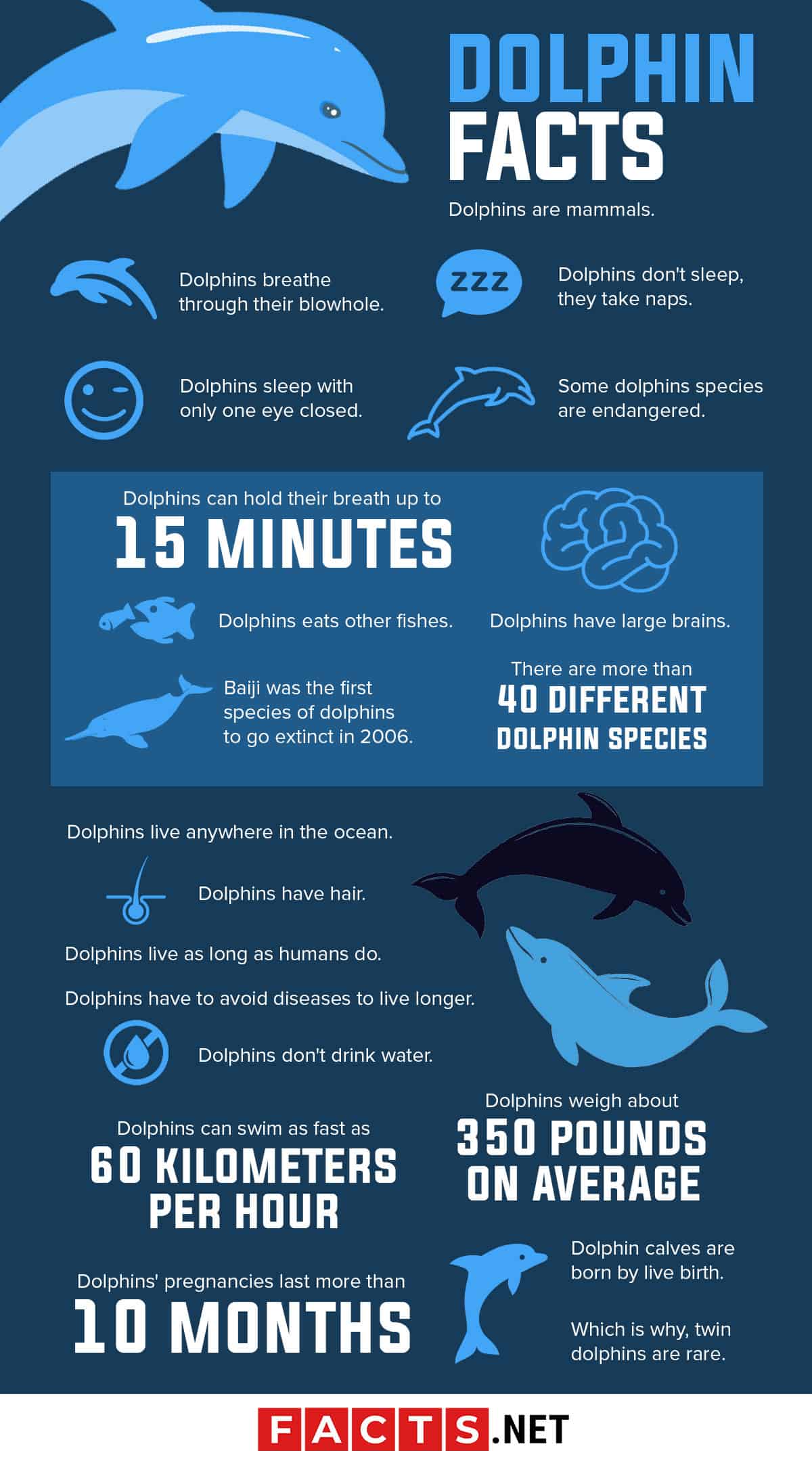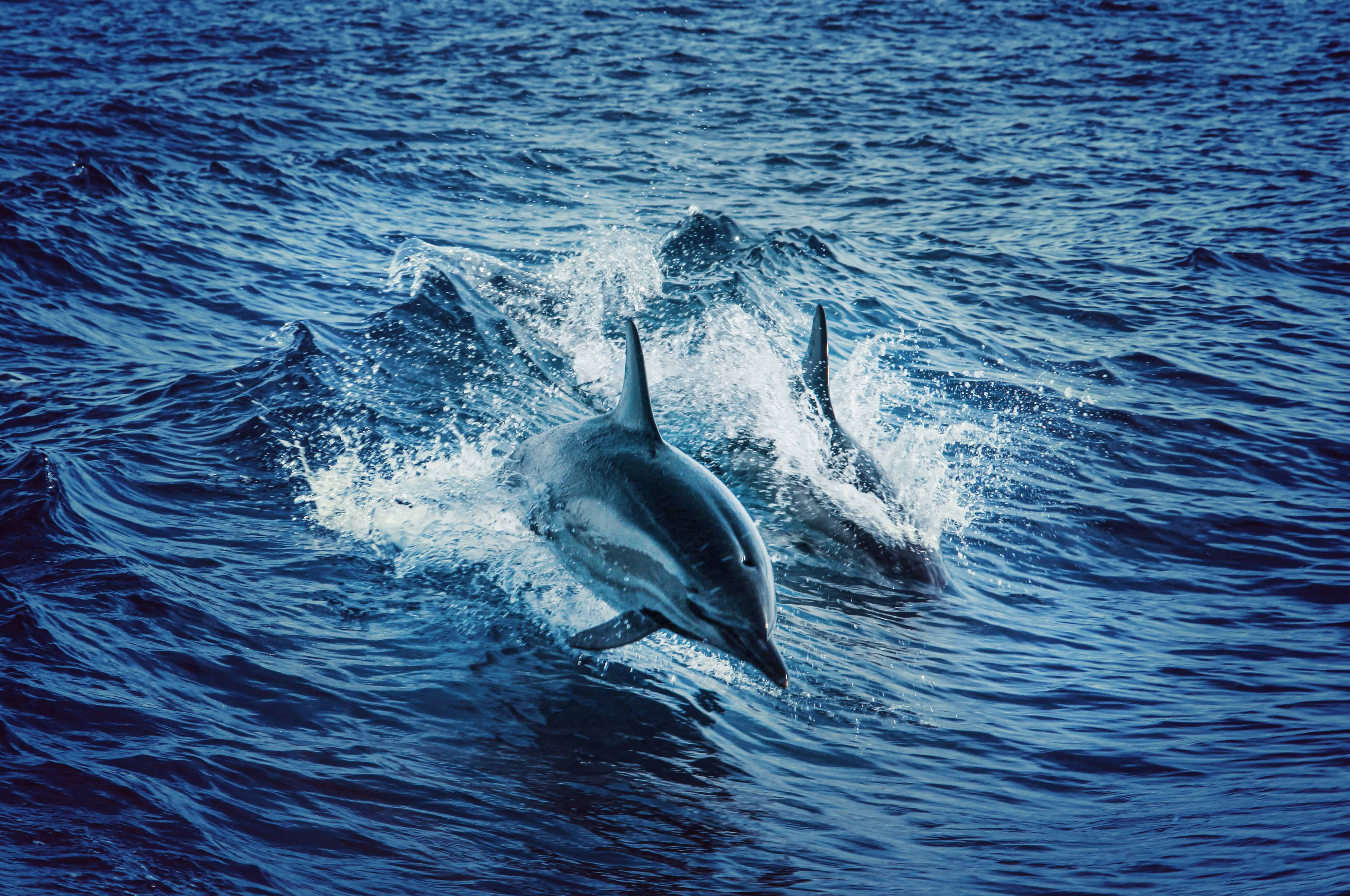
Dolphins are known to be playful animals that are well-loved by both the young and old. They are smart and we usually watch them perform impressive tricks. Let’s find out more about these adorable marine animals in these dolphin facts.
- Humans are the most dangerous enemy of dolphins.
- Feeding or touching a wild dolphin is illegal in the U.S. waters.
- In the animal kingdom, dolphins have the longest memory.
- The brain of the dolphin is larger than a monkey’s brain.
- A dolphin can kill a shark using its nose.
- Dolphins live in a group called pods, they are tremendously social and they hunt and play together as a group that can reach up to 1,000 members.
- The dolphin can throw out air from its blowhole at a speed of 160 kilometers per hour.
- Dolphin calves nurses up to two years and stay with their mother’s care from three to eight years.
- Killer whales are dolphins, and dolphins are part of the family of whales that includes pilot whales and orcas whales.
- The most popular and common dolphins are the bottlenose dolphins.
- Dolphins don’t have a sense of smell, but they have a sense of taste and the can differentiate saltiness, bitterness, sweetness, and sourness.
- Dolphins have 2 stomachs and they use it separately for food storage and digestion.
- Dolphins are smart enough to improvise “tools” in the ocean, they use sea sponges to protect their nose when hunting food.
- The killer whale is the biggest dolphin.
- Scientists discovered that dolphins can recognize themselves in the mirror.
- Dolphins can use echolocation, a sensory system of dolphins, in which usually high-pitched sounds are released and their echoes interpreted to determine the direction and distance of objects.
- The rarest dolphin is the Māui dolphin.
- Dolphins swims fast because they have smooth skin that reduces drag while swimming, and their outer skin layer regenerates every two hours.
- Dolphins are not monogamous.
- The dolphin will bite if they are angry, frustrated, or afraid.
Dolphin Facts Infographics

Dolphins are mammals.
Yes, just like humans, the dolphins can’t breathe underwater, they need to swim up to the surface of the ocean from time to time and inhale oxygen.
Dolphins breathe through their blowhole.
Their blowhole has a muscular flap that covers it when they are underwater and also keeps the water out of their lungs.

Dolphins don't sleep, they take naps.
Dolphins are mammals, but how do they sleep without drowning? The dolphins are cautious not to fall asleep, instead, they take short naps throughout the day. Dolphins manage their time very well in between napping and breathing.
Dolphins sleep with only one eye closed.
Dolphins practice this method to stay conscious and alert all the time, allowing one side of the eye to rest while using the other to watch for predators. Definitely one of the cooler dolphin facts!
Dolphins can hold their breath up to 15 minutes.
An average dolphin can stay underwater for about eight to ten minutes but some dolphins on its prime can hold even up to a maximum of 20 minutes.
Dolphins have large brains.
Next to the human brain, the dolphin’s brain can be considered as the second most powerful. Dolphins have large brains like humans and they use it to analyze information, solve problems and aggrandize their survival in the wild; also, dolphins alternatingly rest one hemisphere of their brain as insurance not to fall asleep and avoid drowning while taking their nap.
Dolphins eats other fishes.
The newborn dolphin is fully dependent on his mother and suckles thick paste-like milk from her nipples until they learn how to get their food. The food of the dolphins is different for each species. Some eat fishes like mackerel, herring or cod, some others eat squids while large dolphins like the killer whale, they hunt marine mammals like sea lions and seals. The reason why these dolphins are called killer whales is because of their hunting skills and large diets.
There are more than 40 different dolphin species.
There are 44 different dolphin species out there in the wild, and here are 15 types of them: Amazon river dolphin, common bottlenose dolphin, killer whale, striped dolphin, spinner dolphin, short-beaked common dolphin, baiji, pacific white-sided dolphin, short-finned pilot whale, long-finned pilot whale, Irrawaddy dolphin, hector’s dolphin, tucuxi, dusky dolphin, and the Bolivian river dolphin.
Some dolphins species are endangered.
There are mixed reasons and factors why the dolphins are lowering in numbers and commercial fishing is one of them; dolphins get trapped in the fishing net and die from drowning. Some dolphins are captured by humans as a food source despite its high mercury content and toxicity levels.
Baiji was the first species of dolphins to go extinct in 2006.
Also known as the “Goddess of the Yangtze, the Baiji dolphins were driven to extinction by human acts. However, there have been reports in 2016 that these dolphins were spotted jumping out of the Yangtze river, although searches after had been fruitless. The Baiji dolphins are currently listed as “Critically Endangered”.

Dolphins live anywhere in the ocean.
While most dolphins inhabit the saltwater, some of them flourish in the freshwater like rivers. The habitat of dolphins changes according to environmental and food opportunities.
Dolphins have hair.
However, their hair falls out shortly after birth. Their hair can be found at the top of the rostrum, and dolphins cannot grow their hair anymore after this phase.
Dolphins live as long as humans do.
Their life span varies to its environment and species but the average age is between 15 to 20 years. Although some species like the bottlenose dolphin can reach 40 years of age – it is comparable to a human living to be 100 years of age.
Dolphins have to avoid diseases to live longer.
A variety of diseases and parasites can shorten the life of a dolphin, including viral, bacterial, and fungal infections. They are also not immune to stomach ulcers, skin diseases, heart disease, and respiratory disorders.
Dolphins can swim as fast as 60 kilometers per hour.
Dolphins usually swim between 20 to 30 kilometers per hour on average but they can go up to 60 kilometers per hour they pushed it, that is why we can see dolphins catching up and playing around the speedboats and ships in the oceans.
Dolphins weigh about 350 pounds on average.
In general, the dolphins are 2 to 3.9 m (6.6 to 12.8 ft.). Their average weight is 150 to 200 kg (331.5 to 442 lbs.).
Dolphins don't drink water.
Their main food (fish and squid) contains a good amount of water and so dolphins gain water from their food. In other words, dolphins don’t need to take in very much fluid because, unlike humans, they don’t lose water by sweating. One of the strange dolphin facts good to know!
Dolphins' pregnancies last more than 10 months.
Depending on their species, dolphin pregnancies last between 10 months to 18 months.
Dolphin calves are born by live birth.
Unlike most mammals, dolphins are designed to give birth tail-first to minimize the risk of drowning. Dolphins give birth to a single baby that takes about a couple of hours.
Which is why, twin dolphins are rare.
Twin dolphins are possible. When this happens, one of the calves may die as their mother is not able to take care of two calves at the same time.
Young dolphins learn from their mothers.
After dolphin calves are born, they stay with their mother for the next 3 to 8 years. There are three important lessons that calves need to learn, it is hunting, socializing in the pod and to defend itself from other dolphins.

The deepest dive ever recorded by a dolphin was close to 1000 feet.
A dolphin named Tuffy that was trained by the US Navy recorded a 300 meter (990 feet) dive. Marine mammals like dolphins are used to patrol some parts of the ocean and act as lookouts for enemy ships. With their sharp senses, they can spot enemies and they are trained to carry tracking devices, cameras, and even explosives if needed. Dolphins are also often used to assist divers for navigation.
Dolphins have teeth, but they don't chew their food.
Dolphins have 72 – 104 teeth and they only get one set of teeth in their lifetime. But even having as many as 100 teeth, dolphins don’t chew their food; they only use their teeth to catch food, then they swallow it directly.
Dolphins are smart.
These sea creatures are fast learners, they demonstrate self-awareness, analytical thinking, innovative, and playful.
Dolphins are compassionate.
There have been many documented cases of dolphins rescuing humans. Korean scientists once documented a case of an entire group of dolphins working together to save another dolphin who was dying.
Male dolphins fight to win the hearts of female dolphins.
Male dolphins courts a female dolphin by bringing her gifts, performing aquatic maneuvers, and may sing to his loved one; however, if there are multiple suitors, male dolphins will fight to determine who wins the right to mate with the female dolphin. When the male and female dolphin mate, it will only take about 10 seconds and they can repeat several times a day.
The female dolphins raise their calves on their own.
While the male dolphin will carry on finding a new female dolphin partner.
Male dolphins can be attracted to each other.
Some of the male dolphins have shown that they can be attracted to each other, and these so-called “gay dolphins” have been spotted and observed in Western Australia; this dolphin behavior is not yet well understood but it is believed that the male dolphins can be amazed by the hunting and social skills of the other male dolphins.
Dolphins communicate with each other through whistles.
Dolphins do not have outer ears, but they hear through a highly developed hearing sense located in two small openings on both sides of the head; it is believed that they hear through the lower jaw bone directing the sound towards the middle ear. Dolphins make two different sounds, (clicks and whistles). Clicks are used to sense the surroundings and whistles to communicate with other dolphins.
Dolphins don’t interrupt each other while communicating.
A recording of two black bottlenose dolphins exchanging sounds in a way that resembled a conversation between two people has sparked interest in scientists. These dolphins took turns producing sounds and did not interrupt each other. While scientists believe that the dolphins were speaking in sentences, many others call their bluff. Either way, the advanced communication skills of dolphins cannot be ignored compared to other animals.
Dolphins used to have 4 legs.
Archaeological evidence shows that the dolphins evolved from a four-legged animal that was initially semi-aquatic to mostly-aquatic and now to a fully-aquatic marine mammal. The original dolphin is named Pakicetus and lived about 50 million years ago.
Dolphins are what they look like now for 5 million years.
After evolving 50 million years ago from a four-legged animal, the dolphins with current physical characteristics today existed 5 million years ago.
Sharks are dolphins' predators.
The primary predators of dolphins are the great white shark, tiger shark, bull shark, and the dusky shark; these sharks try to sneak coming from behind or below them. Sharks generally don’t eat dolphins but they do these attacks to protect their territory.
A dolphin was once trained to attack sharks.
A trained dolphin named Semo was trained by researchers to attack sharks. Semo quickly learned to use headbutt on lemon sharks, sandbar sharks, and nurse sharks on command; but when a bull shark was introduced to Semo on the pool, he did not attack the bull shark and refuses to listen in the command, it was evident that Semo recognizes the danger. Bull sharks are known to attack and occasionally eat newborn dolphin calves, right after the experiment, Semo was removed safely in the pool. Semo was released back into the wild a few weeks after the training and experiments.

Killer whales are actually dolphins.
These dolphins are called killer whales because of their size and hunting skills. The size of a killer whale can be compared to a real whale while retaining its “dolphin hunting skills”
Killer whales also attack dolphins.
The killer whales’ favorite meals are sea birds, squid, octopuses, sea turtles, sharks, rays, and fish. They also eat most marine mammals, such as seals and dugongs but from time to time if they are not available, they would also consume dolphins.
Killer whales are apex predators.
Killer whales do not have natural predators, placing them on top of the food chain in the ocean.
Dolphins can jump high into the air.
Before dolphins jump high into the air, they need to generate speed underwater, combining with their light streamlined body, it makes it easy for them to leap into their air with such stunning heights.
Dolphins can jump up to 30 feet above the water.
It is easier to travel in the air than in water, as water is denser than air. Therefore dolphins sometimes jump as they can travel further as compared to using the same amount of energy to swim in the water.
There are good reasons behind why dolphins jump.
Dolphins also jump due to other various reasons: to locate the pod, to take a breather while saving energy as it takes less effort to be in the air than in the water, to communicate and socialize while hunting together, and to get rid of parasites.
Dolphins eat as much as 9% of their body mass every day.
An average dolphin eats as much as 4% to 9% of their body weight per day.
There are midwife dolphins.
A female dolphin can help a pregnant dolphin if she is having difficulties giving birth. The “midwife” dolphin helps to pull out the baby while the other dolphins will swim around the mother during birth for protection.
Dolphins have a 300-degree panoramic vision.
The dolphin’s eyes are placed laterally in the sides of their heads and they can move it independently, which enables them to look at two different directions at the same time.
Dolphins swim by moving their tail in an up and down motion.
Unlike the fish, which budges its tail from side to side, dolphins swim by moving its tail in an up and down motion.
Dolphins love the big screen.
Even Hollywood loves dolphins. In 1964, the television series Flipper premiered and was well received by the public. It followed Flipper, a bottlenose dolphin, and his companion Porter Ricks. The series ran for three seasons. Flipper was portrayed by a total of five different dolphins. There was, however, also a spark for controversy as animal activists disagreed with keeping dolphins in captivity.
Was this page helpful?
Our commitment to delivering trustworthy and engaging content is at the heart of what we do. Each fact on our site is contributed by real users like you, bringing a wealth of diverse insights and information. To ensure the highest standards of accuracy and reliability, our dedicated editors meticulously review each submission. This process guarantees that the facts we share are not only fascinating but also credible. Trust in our commitment to quality and authenticity as you explore and learn with us.
